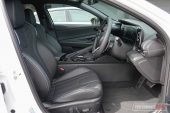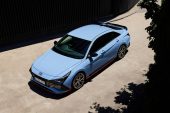Yes, it’s another high-performance N model from Hyundai. Welcome to the i30 Sedan N, otherwise known as the Elantra N in some markets. This joins the showroom with no direct rival, making it an easy score for anyone in this space.
Like the Kona N, this new performance sedan doesn’t really have any direct rivals. Sure, there is the Honda Civic Type R, but that’s a hatchback (and no longer available), and you have the Audi S3 sedan (priced from $65,800) but that’s a premium all-wheel drive offering.
Instead, this goes its own way. It packs the same 206kW/392Nm 2.0-litre turbo punch as the brilliant new i30 N hatch, and it’s available with either the beaut new eight-speed dual-clutch auto or a six-speed manual. We can’t express how delighted we are, as driving and car enthusiasts, to have such options available in Australia.
Speaking of which, Australia is one of the biggest markets for N models, and we are one of the only ones offered the complete range – we did miss out on the Veloster N but that is now defunct.
The range is very simple; it comes in i30 N Premium form only, and buyers can choose either transmission at no extra cost. Prices start from $49,000 (excluding on-roads). And we know, that is steep, especially for a ‘Hyundai’, but don’t worry. You do get a lot of car for the money. It is worth noting that, spec-for-spec, this undercuts the i30 N Premium hatch by $3000 if you opt for the DCT auto.
2022 Hyundai i30 Sedan N – THE SPECS
[column width=”47%” padding=”6%”]Engine: 2.0-litre turbo four-cylinder
Output: 206kW@6000rpm / 392Nm@2100-4700rpm
Transmission: Eight-speed dual-clutch auto (manual available)
Drive type: Front-wheel drive, limited-slip differential
Wheels: F & R: 19×8.0, 245/35
ANCAP: Not tested
Tare weight: 1440kg
Power-to-weight: 6.99:1 (kg:kW)
Official fuel economy: 8.2L/100km
Fuel capacity/Type: 47L/95 RON[/column] [column width=”47%” padding=”0″]Power efficiency: 25.12kW:L/100km
0-60km/h: 3.07 seconds*
0-100km/h: 5.60 seconds*
60-110km/h: 3.40 seconds*
1/4 mile: 13.88 seconds at 169.7km/h*
Max acceleration: 0.818g
100-0km/h braking: 2.91 seconds at 37.39 metres*
Max deceleration: -1.186g
Decibel at idle (/N mode): 50/55*
Peak decibel at 60-100km/h: 90*
Priced from: $49,000[/column][end_columns]
* Figures as tested by PerformanceDrive on the day. Factory claims may be different
2022 Hyundai i30 Sedan N – THE PACKAGE
We loved the regular i30 sedan and N Line we it came out. And they still are very thorough, quality, and well-packaged options. Like those, this is based on the newer K3 platform, unlike the hatch which retains the K2 layout. Not only does the K3 feature a wheelbase that is 70mm longer, it’s also 30mm wider. Both help to improve stability and handling.
The platform also accommodates a unique MacPherson strut front suspension setup and a multi-link rear – no torsion beam crap back here. The N version adds a heavy-duty integrated hub arrangement, called Integrated Drive Axle. It merges the hub and axle assembly into one unit, resulting in fewer parts, less weight, and more importantly, an overall stronger system. It features a larger wheel bearing too which will no doubt improve heat dissipation.
There’s also various chassis reinforcements to help increase rigidity by 25 per cent, and of course a custom sports suspension system complete with three-mode dampers. The electronic stability control (ESC) has a bespoke tune and users can employ an ‘ESC Sport’ setting that allows for some slip and play, including a surprisingly high amount of tail-out fun.
One of the great aspects of the sedan, aside from all the hardcore N stuff, is the interior. We love the design. It’s really modern, and most areas are treated to good quality coverings. Although, the glove box, handbrake lever and sections of the dash and door cards still retain off-putting elephant-skin hard scratchy plastics. But this is not really a criticism directed at Hyundai but many brands out there, including premium ones – replace this stuff already, with something more contemporary.
Passenger ergonomics are absolutely superb. You sit hunkered down in the N, and the steering column and pedal placement is very well thought out. Obviously product control at Hyundai is very thorough, with actual driving enthusiasts making sure areas like this are perfect before it runs out the door. Not just a ‘that’ll do’ approach.
Despite a unique enclosed centre console, skewed toward the driver, passenger space is also very good. It doesn’t feel claustrophobic, as the floor seems really flat and there is a level of airiness around the front of the cabin. Headroom and legroom are fine, unless you have trouble walking under conventional doorways.
Rear seat space is also very open and airy, and there are climate vents in the back of the centre console. Unlike the regular sedan though there is no flip-down centre arm rest and cup holders. This is disappointing as we like the think there is a certain level of grand touring nature about this model. Without such amenities this quality is obviously reduced.
Boot space is measured at 464 litres, which is 10L less than the regular sedan. We’re guessing that is due to the chassis brace that runs across the rear bulkhead. But the boot is around 80L larger than the i30 N hatch and about 100L larger than the Kona N. A space-saver spare wheel sits under the boot floor.
2022 Hyundai i30 Sedan N – THE DRIVE
For this launch event the drive program consisted of some highway driving, lots of windy road sprinting – including on poorly-maintained country roads – and then many laps at Sydney Motorsport Park. Since these conditions are not really likely to mimic real-world scenarios we have left our ‘economy during test’ section out. The official average is 8.2L/100km for both manual and auto.
Firstly, the highway portion of the drive. This is where the i30 Sedan N demonstrates its grand touring suitability. The longer wheelbase (than the hatch) inherently enhances stability, and gearing, particularly in the DCT auto, requires only gentle revs (about 1600rpm) to maintain the national speed limit.
Although the steering is engaging and moderately quick in gearing and response, you don’t need to constantly make fine adjustments to remain centrally planted in lanes. Noise levels are also low, even with the sports exhaust producing a bellowing albeit subdued note in comfort mode. According to our decibel gauge the idle noise level is 50dB and up to 90dB in sports mode at full throttle.
Out on country roads the car does not feel out of its depth. Hyundai Australia did conduct local testing and tuning, but engineers told us most of the local tweaking consisting of software adjustments, as the package handed over from HQ seemed already synced with the usual local team’s protocols. The default driving modes for the suspension provide a surprisingly cushy and absorbent characteristic, taking in divots and tarmac clumps with good compliance and control.
However, we did – accidentally – hit a few surface imperfections which sent a crashing thud through the cabin. We don’t think it’s worth noting as a criticism though as we have driven other hot hatch type vehicles which really crash and bang in similar situations. Also, an easy fix is simply switching to the mid or high damping setting. With firmer compression, such bumps are caught with better bracing and preparation.
The most fun area (aside from the racing circuit) with this vehicle for us is through windy roads, laid with smoothish surfaces. Obviously such conditions are fun for a lot of cars, but this is where the i30 N really comes alive. When you up the tempo you start to notice how direct and darty the front end can be, and learn just how much lateral grip is available when you throw it in as a result of the pokey front end.
In the hatchback it is easy to provoke the tail to step out, almost purely because of how easy you can chuck it into a corner. In this though grip levels are maintained to a higher threshold, it seems. Whether that’s because of the longer wheelbase, or the upsized (and superior, in our opinion) Michelin Pilot Sport 4S 245/35 tyres (235s on the hatch and Kona N), we can’t say for sure. But it is noticeable.
The car remains very flat and neutral if you maintain a smooth driving line on the track, and you can get on the power quite early and the limited-slip differential will sort things out. In fact, the diff is marvellous. We had a hoot at Sydney Motorsport Park playing around with the all the settings, including the two-mode diff settings.
Our quickest lap in the DCT auto was 1:54.07, and 1:53.58 in the manual. We’re not sure why we were quicker in the manual. Perhaps the gearing, including the final drive, were better suited to some crucial corners? Obviously operator error can be the blame, too! Because, the DCT should be quicker. It’s quicker in outright acceleration, with a claimed 0-100km/h time of 5.3 seconds (5.8 in manual), and we recorded it in 5.60, with well-worn tyres.
2022 Hyundai i30 Sedan N – THE VIDEO
2022 Hyundai i30 Sedan N – THE VERDICT
Well, as expected, this is an exceptional little sedan. How can it not be if the regular i30 sedan and particularly the N Line sedan are already hugely commendable products? This thoroughly blends real-world practicality with awesome go-fast character and genuine engineering know-how, resulting in what we believe is the best all-round sub-$50k sports sedan currently on the market.
Do we recommend this over the hatch? My personal opinion is yes. The boot is around 100L bigger, you get the latest platform which is more dynamic (albeit slightly less playful), and the interior really edges ahead thanks to its contemporary design that’s also very practical. Obviously, we’d take a hatchback in a heartbeat, but keep in mind you also save $3000 going with the auto sedan over the auto hatch (in Premium form).
As always, if you’re thinking about buying a new car don’t forget to click here to speak with our car buying specialists.






























